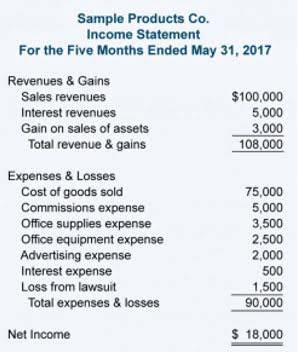
Because a cash book is updated and referenced frequently, similar to a journal, mistakes can be found and corrected day-to-day instead of at the end of the month. Think of your accounting journal as the first record of each transaction. The ledger uses the T-account format, where the date, particulars, and amount are recorded for both debits and credits. It includes the transaction date, particulars of the transaction, folio number, debit amount, and credit amount. Transactions that occur frequently—such as revenues, cash receipts, purchases, and cash payments—are typically recorded as journal entries first.
- The company’s bookkeeper records transactions throughout the year by posting debits and credits to these accounts.
- An accounting ledger is used to prepare a number of reports, such as balance sheets and income statements, and they help keep your small business’s finances in order.
- Sub-ledgers are great for accounts that require more details to review the activity, such as purchases or sales.
- The balances in these accounts as of the final moment of an accounting year will be reported on the company’s end-of-year balance sheet.
- Her work has appeared in Business Insider, Forbes, and The New York Times, and on LendingTree, Credit Karma, and Discover, among others.
See advice specific to your business
Check out the post “Maintaining a General Ledger” from Wolters Kluwer for a more extensive list of general ledger accounts that might apply to medium to large businesses. An organization located in a unique industry may find that it requires additional accounts beyond the ones noted here. Thus, which accounts are found on an income statement the exact set of income statement accounts used will vary by company. The accounting ledger – sometimes called the general ledger (GL) – provides a centralized repository to collect all account data rolled up from subledgers or modules, making it the backbone of any corporate financial system.
![]()
Is a General Ledger Part of the Double-Entry Bookkeeping Method?
- The transactions are related to various accounting elements, including assets, liabilities, equity, revenues, expenses, gains, and losses.
- The image below is a great illustration of how the blockchain distributed ledger works.
- For balance sheet accounts, the opening balance is usually the closing balance from the previous period.
- A general ledger summarizes all the transactions entered through the double-entry bookkeeping method.
- Transactions from subsidiary ledgers are periodically summarized and transferred to the general ledger, which contains transaction data for all accounts in the chart of accounts.
- The income statement shows the performance of the business throughout each period, displaying sales revenue at the very top.
Financial models use the trends in the relationship of information within these statements, as well as the trend between periods in historical data to forecast future performance. For the past 52 years, Harold Averkamp (CPA, MBA) hasworked as an accounting supervisor, manager, consultant, university instructor, and innovator in teaching accounting online. For the past 52 years, Harold Averkamp (CPA, MBA) has worked as an accounting supervisor, manager, consultant, university instructor, and innovator in teaching accounting online. Make columns on the far left of the page for the date, transaction or journal entry number, and description.
- In accounting, a General Ledger (GL) is a record of all past transactions of a company, organized by accounts.
- In the double-entry system, each financial transaction affects at least 2 different ledger accounts.
- The general ledger also helps you compile a trial balance, spot unusual transactions, and create financial statements.
- The trial balance totals are matched and used to compile financial statements.
- This means that the balances in the income statement accounts will be combined and the net amount transferred to a balance sheet equity account.
Get live expertise
But you don’t have to be intimately acquainted with journals and ledgers to keep tabs on the financial health of your business. Using the best accounting software or working with a professional bookkeeper or accountant makes it easier to record every transaction and make sure they balance every time. The set of 3-financial statements is the backbone of accounting, as discussed in our Accounting Fundamentals Course. A general ledger summarizes all the transactions entered through the double-entry bookkeeping method.
Under this method, each transaction affects at least two accounts; one account is debited, while another is credited. The total debit amount must always be equal to the total credit amount. Some general ledger accounts are summary records called control accounts.
- Accounting ledgers are maintained for all types of balance sheet and income statement transactions.
- This ledger is often also used to keep track of items that reduce the number of total sales, such as returns and outstanding amounts still owed.
- They can also result from journal entries, such as recording depreciation.
- The set of 3-financial statements is the backbone of accounting, as discussed in our Accounting Fundamentals Course.
- Have more time to work on what you love when you spend less time on bookkeeping.
When expenses spike in a given period, or a company records other transactions that affect its revenues, net income, or other key financial metrics, the financial statement data often doesn’t tell the whole story. In the case of certain types of accounting errors, it becomes necessary to go back to the general ledger and dig into the detail of each recorded transaction to locate the issue. At times this can involve reviewing dozens of journal entries, but it is imperative to maintain reliably error-free and credible company financial statements. Companies can maintain ledgers for all types of balance sheet and income statement accounts, including accounts receivable, accounts payable, sales, and payroll. Transactions from subsidiary ledgers are periodically summarized and transferred to the general ledger, which contains transaction data for all accounts in the chart of accounts.
Upgrading to a paid membership gives you access to our extensive collection of plug-and-play Templates designed to power your performance—as well as CFI’s full course catalog and accredited Certification Programs. From there, gross profit is https://www.bookstime.com/ impacted by other operating expenses and income, depending on the nature of the business, to reach net income at the bottom — “the bottom line” for the business. Ledgers contain the necessary information to prepare financial statements.

How a General Ledger Functions With Double-Entry Accounting
After that, the bookkeepers can post transactions to the correct subsidiary ledgers or the proper accounts in the general ledger. While many financial transactions are posted in both the journal and ledger, there are significant differences in the purpose and function of each of these accounting books. Make columns on the right side for debits, credits, and running balance.
